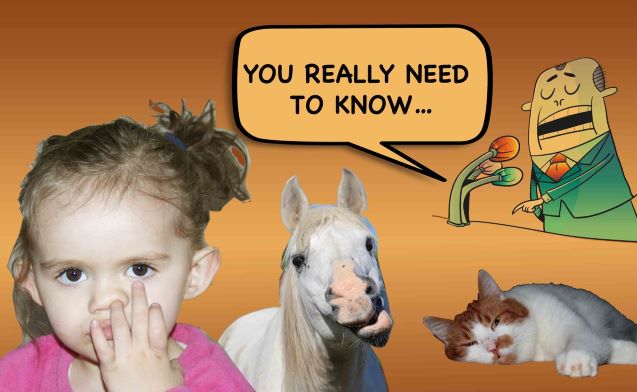
We writers are very sneaky people. We lie to our readers constantly, luring them into imaginary situations and manipulating their emotions shamelessly under the pretense that we are entertaining them. And all the while, what we really want to do is preach to the reader about how the world works and how to make it go better. The difference between a good writer and a bad writer is that the good writer doesn’t get caught. Good writers make readers need what we want to tell them. Less experienced writers start their novels only thinking about what the reader needs to know in order to understand.
“You Need to Learn This”
From the author’s point of view, a novel is about ideas: humanity, society, individuals. So we make up our own versions of humanity, society, and people, and use their interactions to demonstrate those ideas.
“Entertain Me.”
As far as the reader is concerned, a novel is about people doing things. That’s it. Characters in conflict.
So when you sit down to write a novel, you say, “I want to write a novel about ……(your choice of burning social evil)…… but in order to understand what’s going on, the reader needs to know about…
Whoa. Hold it Right There
The reader doesn’t need anything of the sort. The reader needs to be entertained, and he hopes your book will do that. If you fill the first pages up with backstory, philosophical discussion, and all those ideas circulating in your head, you’re gonna get busted. The reader gives you the “Papa Don’t Preach” response and puts down the book.
Character Portrayal
Characters are the first strength of a good book. Our mistake is that, because the characters are most important to us, we think we have to lovingly create all the people and relationships before we start the action. We think to ourselves, “In order to understand the story once it starts, the readers need to know this about the main character, and this, and…oh, yes, of course this, and wouldn’t if be nice if they knew…” and away we go for three chapters, and the story hasn’t started yet.
Putting Stuff in Dialogue
Putting the author’s words into the characters’ mouths is the most popular way of cheating on this. Different genres have different rules about that technique. The general rule is that information in dialogue is more palatable to the reader than a sermon from the author, unless it reaches the point where it’s obvious that the character is just a mouthpiece for you-know-who.
Trite and True
Any technique that is overused starts to become more and more obvious after a while. So “As she left the house, she glanced at herself in the mirror and saw…” elicits a “Here we go again,” response and a skip to the next paragraph.
Readers Don’t Mind Guessing Games
If you really must describe some aspect of the character’s looks because they are really important to the story, you have to create a need in the reader.
As Tracy left the house, her mother shouted from the kitchen. “You’re not going out looking like that!”
Tracy pretended not to hear, and walked on.
Then we leave it for a few paragraphs before the next hint.
Mrs. Jones was walking little Toby, who usually ran up to Tracy for attention. Today, the dog cowered on the opposite side of his mistress, running out to sniff at Tracy’s heels as she strode on past, her shoulders straight.
By this time, the reader is intrigued and can’t wait to find out what the heck is going on. Now the author is free to spend some time describing what Tracy looks like; the reader will be happy to absorb the information in detail, and the story goes on. As long as you don’t overdo it. (See “Trite and True” above.)
Relationships
Interactions between characters also work in the opening chapters…sort of. We want to develop relationships between characters as the major focus of the story. Well, people having relationships with conflict in them is entertaining. However, unless we are writing an “intellectual novel,” we have to put some external action in as well. In fact, we want to put some action in. People and relationships reveal their strengths and weaknesses in times of crisis. Charles Dickens didn’t put “Tale of Two Cities” in the middle of a revolution by mistake. A conflict creates the need in the reader to find out how it ends. A balance of internal, external, and interpersonal conflicts keeps the interest going on different levels.
So Remember…
Readers don’t need to know anything. What they need, especially in the first three chapters, is to be grabbed emotionally by the book. This is done through sympathetic characters and exciting conflict, not one at the expense of the other.
It is possible to do both. It’s simply (Simply? Hah!) a matter of structuring the book to make sure there is a good blend of action, description, and character development through the first few chapters. Only then will those ideas that are burning up your pen come to light.
As long as we are fulfilling a need for information, the reader will not notice if we ramble on a bit. If, however, we are giving a bunch of information that the reader doesn’t feel he or she needs, then the chapter becomes an information dump. And we don’t need to dump on our readers, do we?

Great article and reminders of what works. Thanks so much!
So true! I once read that the first draft is for the author, in order to get down all those things the author needs to know. The second/third/fourth etc draft is for the reader, using the less is more principle. 😀
I’ve just been reading a book that begins with an awful lot about ties. As the protagonist is supposed to be a sociopath, I kept reading, and now I’m glad I did, but that beginning could have been a whole lot less and still conveyed the idea. 🙂
I like your approach to the different edits. After all, most of editing involves taking things out 🙂
Thanks, Gordon!
You’re right: Readers don’t mind guessing games. Sometimes the guessing is the best part of a book — as long as the writer reveals the facts when they’re needed.
You’ve nailed it. The relationship between reader and writer is a game in which the writer holds all the cards. It’s up to the writer to distribute them fairly, or the reader will take his money and go home.